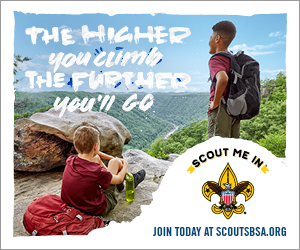10 Essentials
Prepared. For Life. It’s more than a motto for Scouting; it’s a way to plan and execute each outing, even if it’s just a Saturday morning hike. In the woods, the items here (stowed in a daypack) can keep you comfortable, warm, hydrated, safe and, most of all, prepared to face what nature puts in your path — whether you asked for it or not.
This list is based upon the Scout Basic Essentials included in the Boy Scout Handbook and Fieldbook with a few twists.
A POCKET KNIFE
Essential #1
A pocket knife is the all-purpose tool of the outdoors. Use it to cut cord, trim a bandage, slice cheese, whittle a tent stake, open a can, tighten a camp stove screw, and take care of hundreds of other tasks. Choose a quality knife that includes one or two sharp blades, a can opener, and a screwdriver. Invest in a good knife now, and it will serve you well through years of adventures.
FIRST AID KIT
Essential #2
Having basic first-aid items on hand will allow you to treat minor injuries and to provide initial care if more serious emergencies arise. Zippered into a self-sealing plastic bag, a personal first-aid kit has what you need to treat a blister, clean a wound and bandage a cut.
SUN PROTECTION
Essential #3
Sunburn is among the most common injuries suffered by people who enjoy being outdoors. Repeated sunburns can cause long-term skin damage and the potential for skin cancer. While people with fair skin are the most at risk, everyone should be aware of the dangers of too much sun and should take steps to protect against it. Use sunscreen with at least an SPF of 15. Wear a broad-brimmed hat, long-sleeved shirt and long pants to provide more complete protection. Sunglasses are also a good choice.
MAP AND COMPASS
Essential #4
Staying found is an important responsibility for anyone traveling outdoors. Learning to navigate on trails, over water and across open country can bring a great sense of enjoyment and confidence. Carry a map of the area you are exploring, along with a simple compass to help make your way through unfamiliar terrain. Even when they aren’t essential for route-finding, practicing with navigational tools can be fun. Practicing will help prepare you for times when you might need to rely on these tools.
Filled WATER STORAGE
Essential #5
How much water you’ll need depends upon what you will be doing and whether you can replenish your supply along the way. Hot and humid conditions increase your thirst, but you need to drink plenty of fluids in cold, dry weather, too. An inexpensive option is to simply rinse plastic water or soda bottles and fill them with drinking water. Or, you can choose a wide-mouthed plastic bottle that’s easy to fill and clean. Other options include a hydration pack or collapsible water jug. Portable water purifiers and water stills may be used to obtain potable water from virtually any source. If a water-source is unavailable the use of a dromedary bag should be considered.
FLASHLIGHT OR HEADLAMP
Essential #6
You might intend to be home before nightfall, but things don’t always go as planned. A flashlight will illuminate a site as you set up camp in the dark or light up a trail as you find your way after the sun has gone down. Carry spare batteries, as well. A handheld flashlight can be heavy and sometimes awkward to use, but they are fine for trips not limited by the amount of weight you can carry. A compact headlamp powered by AA or AAA batteries, with an elastic band that fits around your head, will free your hands for hiking when visibility is limited, for dealing with emergencies after dark and for reading in a tent.
TRAIL FOOD
Essential #7
You will be very happy to have an emergency supply of trail food if a trip in the field lasts longer than planned or if your provisions run out sooner than you expected. Rely on foods that are compact, high in energy and unlikely to spoil — a small bag of granola, for example, and perhaps an energy bar or two.
MATCHES AND FIRE STARTERS
Essential #8
Plan your clothing, shelter and meals well enough that you won’t need a campfire. But be prepared to build one in the event of an emergency. Carry several different kinds of fire sources so if one fails, you’ll have a backup. Matches, butane lighters, tinder aids, traditional fire starters are all good examples. A firestarter may be used to light fires for heat, or for signalling purposes. (Publicly owned forests in the United States often have lookout stations for forest fires and signal fires.
EXTRA CLOTHING
Essential #9
Weather in some backcountry can change — sometimes with startling swiftness. Have the clothing you need to deal with the extremes of heat, cold and storms. For summer campouts close to home, you can probably find most of the clothing you need in your closet. Using a layering system allows you to stay comfortable by adding or removing clothes as the weather changes. Falling temperatures and the possibilities of rain or snow require more attention to what you wear and the additional clothing you carry.
RAIN GEAR
Essential #10
Be prepared to face the elements with rain protection in the form of a shell jacket, pants and more.
Whistle
Essential #11 (Bonus Item)
A whistle is listed on many lists used in the Scouting program.


